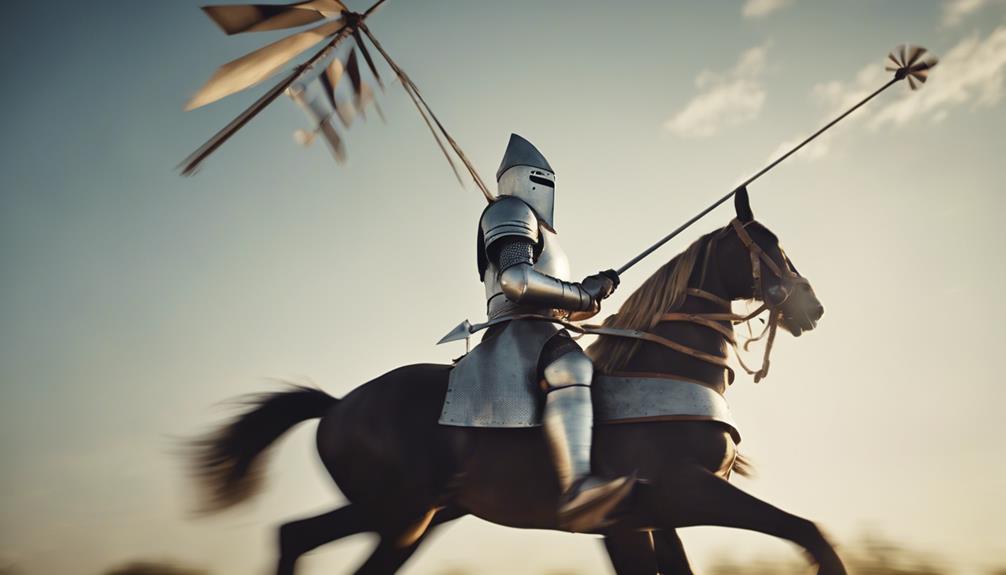Understanding the true meaning of 'tilting at windmills' involves battling illusions and chasing unattainable dreams. Originating from 'Don Quixote' by Miguel de Cervantes, it symbolizes fighting imaginary foes or pursuing unrealistic goals. This idiomatic phrase warns against misguided endeavors, cautioning individuals to differentiate between genuine challenges and illusory obstacles. By recognizing when one is 'tilting at windmills,' efforts can refocus towards achievable objectives. Learning the balance between realism and idealism is key to avoiding the pitfalls of pursuing mere illusions. Uncover more insights into this timeless concept and its relevance in modern life.
Key Takeaways
- Originates from 'Don Quixote' by Cervantes.
- Symbolizes battling imaginary enemies.
- Critiques pursuing unrealistic goals.
- Warns against unchecked idealism.
- Encourages grounding pursuits in reality.
Origins of the Idiom
The idiom 'tilting at windmills' traces its origins back to Miguel de Cervantes' novel, 'Don Quixote,' written over 400 years ago in Spanish literature. In 'Don Quixote,' the main character, Don Quixote, mistakes windmills for giants and engages in futile battles with them. This misconception leads to the popularization of the idiom, symbolizing the act of fighting imaginary enemies or pursuing unrealistic goals.
Don Quixote's perception of windmills as menacing giants highlights the theme of delusion and the contrast between appearance and reality. The idiom 'tilting at windmills' captures the essence of engaging in fruitless endeavors, akin to fighting inanimate objects. Derived from the medieval sport of jousting, where knights would engage in combat, the idiom emphasizes the futility of battling non-existent foes.
Over time, 'tilting at windmills' has evolved in meaning, representing the pursuit of impractical or unattainable objectives. Understanding the origins of this idiom provides insight into its metaphorical significance and serves as a cautionary tale against chasing illusions.
Symbolism in 'Don Quixote'

Exploring the symbolic depth of 'Don Quixote,' we investigate the intricate layers of meaning behind the windmill encounters in Miguel de Cervantes' novel. These windmills, which Don Quixote famously mistakes for giants, reflect the blurred lines between reality and illusion in the protagonist’s mind, symbolizing the idealized battles that he believes he must fight. Much like the meaning behind Bette Davis eyes, which evokes a sense of mystery and allure, the windmills represent unattainable fantasies that Quixote pursues with unwavering conviction. This delusion underscores the complexities of human perception, where one man’s madness can be another’s mythic quest for honor and purpose.
In 'Don Quixote,' windmills symbolize perceived enemies or obstacles that Don Quixote mistakes for giants, leading to his futile battles against them. This scene vividly illustrates the clash between Don Quixote's vivid imagination and the harsh reality he faces.
The symbolism of windmills reflects the overarching theme of idealism versus practicality in the novel, showcasing the contrast between Don Quixote's romanticized view of the world and the harsh truths he encounters. The phrase 'tilting at windmills' from 'Don Quixote' has become a metaphor for pursuing unrealistic or unattainable goals, capturing the essence of Don Quixote's quixotic adventures.
Through these encounters with windmills, Cervantes masterfully explores a tale that delves into the complexities of human nature, the power of imagination, and the eternal struggle between dreams and reality.
Interpretation in Modern Context
Delving into the modern significance of 'tilting at windmills,' we uncover its relevance in critiquing unrealistic pursuits and misguided endeavors. Stemming from Don Quixote's misidentification of windmills as giants, this concept warns against battling imaginary enemies, mirroring the struggle between fantasy and reality. In today's context, 'tilting at windmills' serves as a cautionary tale against unchecked idealism and the pursuit of unattainable goals. By labeling these actions as tilting at windmills, we highlight the importance of distinguishing between genuine challenges and illusory obstacles.
The phrase has seamlessly integrated into the English language, becoming a metaphor for facing non-existent challenges. It emphasizes the need for individuals to discern between what's real and what's a product of their imagination. When we engage in behaviors reminiscent of Don Quixote's battle with windmills, we risk wasting time and energy on fruitless endeavors. This modern interpretation of 'tilting at windmills' acts as a reminder to ground our pursuits in reality and avoid chasing after mere illusions.
Examples of Tilting at Windmills

In our contemporary society, instances of individuals fixating on unattainable objectives and battling imaginary adversaries serve as clear examples of tilting at windmills. We often witness people who don't recognize the windmills for what they are, similar to Don Quixote mistaking them for giants. This behavior leads them to engage in futile battles, wasting time and energy on pursuits that have no real substance. Whether it's chasing after impossible dreams or trying to solve nonexistent problems, these actions only result in a never-ending cycle of going back and forth with no tangible outcomes.
Individuals who fall into this trap find themselves caught in a loop of frustration and disappointment, much like Don Quixote's delusional adventures. It's essential for us to recognize when we're tilting at windmills and redirect our efforts towards more realistic and achievable goals. By acknowledging the difference between fantasy and reality, we can avoid getting entangled in conflicts with imagined opponents and focus on pursuits that lead to genuine progress and fulfillment.
Lessons on Realism and Idealism
Learning the balance between realism and idealism is essential for avoiding the pitfalls of tilting at windmills. In Miguel de Cervantes' novel 'Don Quixote,' the act of tilting at windmills symbolizes chasing perceived enemies that are, in reality, harmless structures. This metaphor teaches us the importance of distinguishing between what's achievable and what's merely a product of our imagination.
Realism grounds us in practicality, helping us set achievable goals based on logic and facts. It prompts us to assess situations objectively, understanding the limitations and possibilities realistically.
On the other hand, idealism fuels our aspirations and propels us towards innovation and progress. It inspires us to dream big, think creatively, and aim for excellence beyond the ordinary.
Frequently Asked Questions
What Does the Expression Tilting at Windmills Mean?
When we say someone is 'tilting at windmills,' it means they're pursuing unrealistic or futile endeavors, like battling imaginary enemies. This expression comes from 'Don Quixote,' where the main character mistakes windmills for giants.
It symbolizes wasting time and energy on pursuits that are unattainable or not based in reality. People may be accused of 'tilting at windmills' when they fixate on fighting perceived threats that are insignificant.
What Is the Story of Tilting at the Windmills?
The story of tilting at windmills originates from Miguel de Cervantes' novel 'Don Quixote.' In the tale, the main character, Don Quixote, mistakes windmills for giants and decides to fight them, symbolizing a delusional pursuit of imaginary enemies.
This misunderstanding leads to a series of comical misadventures, emphasizing the futility of engaging in battles with perceived foes that aren't real.
What Does the Phrase Tilting at Windmills Alludes to an Event?
We allude to an event in Miguel de Cervantes' novel 'Don Quixote,' where the protagonist mistakes windmills for giants and engages in futile battles. This tale symbolizes delusional pursuits of imaginary enemies and the clash between fantasy and reality.
'Tilting at windmills' has since become a metaphor for engaging in misguided endeavors.
What Do the Windmills Symbolize in Don Quixote?
In Don Quixote, windmills symbolize perceived obstacles or challenges, representing monstrous enemies to the main character. This delusional belief reflects misguided pursuit of chivalrous adventures.
The encounter highlights the clash between imagination and reality, emphasizing the futility of quests driven by unchecked idealism. The windmills serve as a symbolic reminder of the struggle for personal identity and the consequences of unrestrained idealism.
Conclusion
To sum up, 'tilting at windmills' originated from Cervantes' 'Don Quixote' and symbolizes pursuing unrealistic ideals. In today's context, it serves as a reminder to balance idealism with realism.
For example, striving for perfection in a flawed system may be like tilting at windmills. By understanding the true meaning behind the idiom, we can navigate challenges with a clearer perspective and make more practical decisions.
Let's aim for achievable goals while keeping our dreams alive.











